 Photo by Eason Zhou Photo by Eason Zhou In an ideal world, all of the news coverage and reporting we consume would be a fair account of the events that occur. Journalists would inform the reader of the conflict at hand, provide ample context, and then provide perspectives from both sides of said conflict. Unfortunately, we live in a world where media bias is, more often than not, present in the media we consume. In times of global conflict and massive loss of life it is the responsibility of the press to report from an angle that presents both sides, that provides context to these issues, and that does not use grammar as a weapon against any group of people. This has not been the case for the Israel-Palestine conflict. The United States’ media coverage of the Israel-Palestine conflict since the state of Israel declared war on Palestinian militant group Hamas, has not been presenting readers with a fair view of the Palestinian civilian’s side, instead showing a bias towards the state of Israel. The U.S. media has shown its bias through the diction chosen to inform readers of events that have taken place, the consistent usage of the passive voice to remove Israel from its atrocities committed in Palestine, and the disproportionate coverage of Palestinian death as compared to Israeli death. The presence of this bias in reporting inhibits the reader’s ability to make informed decisions, or to consume media in which factual information is the main focus. Media bias is defined by All Sides as “The tendency of news media to report in a way that reinforces a viewpoint, worldview, preference, political ideology, corporate or financial interests, moral framework, or policy inclination, instead of reporting in an objective way.” The responsibility of the press is to provide us with information, not to feed us a narrative that we then instill in our minds. Despite this, media bias is present in the majority of the media we consume. Think Fox News, which gives biased reporting in favor of the right side of the American political spectrum, or MSNBC, which is biased to the left side of the American political spectrum. Media bias cannot be fully avoided since humans often process information and report from our own standpoints and partialities, and it’s important to remember that media bias is not always a strictly bad thing. What is more dangerous than clear bias, is hidden bias, defined by All Sides as a type of bias that “misleads, manipulates, and divides us.” Our ability to make informed decisions directly relates to how much context we receive on the topic at hand. So, allow me to explain, in the best way I can (in an 18 minute speech), the history behind the Israeli-Palestinian conflict. With the fall of the Ottoman Empire, French, British, and Russian forces came together to discuss how the territory in the Middle East would be influenced and controlled, in a negotiation known as the Sykes-Picot agreement. Sykes-Picot allocated various Ottoman territories to the French, British, and Russian, Palestine, being placed partly under international control, and partly under British control. Concurrently, the British foreign secretary issued the “Balfour Declaration,” which expressed support for “the establishment in Palestine of a national home for the Jewish people.” The British Mandate supported the widespread migration of Jews to Palestine, because of a new movement in Europe called Zionism. The University of Michigan says the goals of Zionism are “all Jews constitute one nation (not simply a religious or ethnic community) and that the only solution to anti-Semitism is the concentration of as many Jews as possible in Palestine/Israel and the establishment of a Jewish state there.” Even though this is a belief held by many members of Judaism, it is not held by all Jews. Furthermore, those who are opposed to Zionism are not inherently anti-semetic, and being opposed to Zionism does not warrant senseless anti-Semitism. It is important to mention that Zionism’s origins come from the continuous persecution of the Jewish people, and the belief that the Jewish ancestral home is where Israel was established. However, the establishment of the state of Israel conflicted with what the British forces had promised Palestinian peoples, independence and a right to govern their own land. The British had been making agreements with both the Palestinians and the Zionists, the British gave the Zionists the right to create a state on the land, the state of Israel. The suffering and persecution faced by the Jewish community throughout history is not something I intend to excuse, and while the Jewish people had an absolute right to flee active violence and genocide against them, the displacement of other ethnic communities after the creation of the state of Israel would have consequences down the road. The State of Israel was established on May 14th, 1948, which immediately sparked the first Arab-Israeli War. Palestinians refer to this time as “Al Nakba” or “The Catastrophe” because during this year 75% (per Institute For Middle East Understanding) of Palestinians were forcibly expelled from their homes and left displaced. This first war ended in 1949 with a victory for Israel, divided the land into three parts, the state of Israel, and the Palestinian territories of the Gaza Strip and the West Bank. Militant and political movement group Hamas has maintained control over the Gaza Strip since 2006, when the group won the Palestinian Authority’s parliamentary elections, and shortly after the group violently took over the Palestinian Authority. Hamas’ violence against civilians and the state of Israel has led to the group’s designation as a terrorist organization by the United States, the European Union, Japan, Australia, Canada, and the United Kingdom. Hamas’ carried out their most recent act of terrorism on October 7, 2023. During the attack Hamas launched over 5,000 rockets into Israel, killing about 1,200 Israelis and taking 253 hostage. Israel responded by declaring war on Hamas, launching air attacks and ground invasions. Since this declaration of war, the Israeli Defense Force have killed about 31,000 Palestinians, and left 70,000 injured, per AP News. Additionally, Israel ordered all Palestinians who live north of Wadi Gaza to leave their homes and travel south, leaving 1.7 million Palestinians displaced, per Congress Research Service. The population of Gaza is 2.1 million, meaning 1.48% of the population has been killed, 3.33% of the population is currently injured, and 80.95% is currently displaced and without a home. Now, let’s discuss the media that much of the American public and residents consume and the ways in which it shows bias towards Israel in its reporting. Language rules the world of news. Journalists are well versed on which words evoke what emotion in readers, they know that diction plays a large part in what their audience takes from the reporting. In the month after Hamas’ October 7th attack, The Column, a media criticism and political analysis substack, published “‘Massacred’ vs. ‘Left to Die’”, a quantitative analysis which documented media bias against Palestinians. The researcher who collected this analysis has remained anonymous, so going forward, I will be referring to the researcher as “Otto” as that is the pseudonym he published his findings under. The portion of this research that I’d like to discuss is Otto’s third finding: That the word “massacre” was used by CNN, FOXNEWS, and MSNBC in 30 second segments more to refer to the 1,200 Israelis killed by Hamas on October 7th, than the 11,000 Palestinians killed by the Israeli army between October 7th and November 7th. FOX NEWS used “massacre” as committed on Israelis 770 times, and committed on Palestinians nine times. CNN used the term 503 times for Israelis, and 53 times for Palestinians. Finally, MSNBC used “massacre” 382 times as committed on Israelis, and 16 times as committed on Palestinians. Interestingly enough, the analysis shows that the term “massacred” was only used to describe Palestinian killings when 1) A Palestinian was directly interviewed, 2) When an advocate for Palestine was interviewed, or 3) It was prefaced by the statement by the reporter, commentator, or news station as “…what is being called a massacre.” In an opinion article in The Washington Post entitled “A silent desperation on the slow march out of Gaza City” by David Ignatious, writes: “This war has produced deeply horrifying images: Israeli children assaulted in barbaric ways by Hamas terrorists; Palestinian children left to die under Israeli bombardment” The choice of wording here is interesting. While Israeli child victims are “assaulted in barbaric ways by Hamas terrorists,” Palestinian children are simply “left to die”? Who are we to assume “left them to die”? Their parents? Based on the fact of the events, it would appear that Palestinian children too are being assaulted in barbaric ways. Israel is air striking their homes daily, causing them to be buried under the rumble of explosions, they are starving to death because Israel is not allowing shipments to come though Palestinian borders, and IDF soldiers continue to kill and fatally injure Palestinian children with every ground invasion they conduct. It’s not that Palestinian children are not being “massacred” or that they are being “left to die” it’s that these media outlets are able to choose specific words to present whatever information or opinion they wish to present, skewing our own view of the topic. According to Otto’s research, the US media is using the English language to change our view of this conflict in favor of Israel. Media outlets should be using words like “massacre” for atrocities involving both the IDF and Hamas, and that when media outlets choose to utilize different words for different parties, we should be able to recognize that and identify that these media outlets are biased. Now, let’s dive into the usage of the passive voice during reporting on the Israeli-Hamas War. There are two main grammatical voices used in writing, the active voice and the passive voice. Purdue University defines the active voice as “the grammar structure in which the subject comes before the object in the sentence and shows a direct action on the object in the sentence,” and then defines the passive voice as “the grammar structure in which the object comes before the subject in the sentence, thus making the action indirect,” Typically, the active voice is preferred in journalistic writing because it is more action driven, concise, and does not leave as much room for ambiguity as the passive voice does. The U.S. media has been utilizing the passive voice to remove Israel as the perpetrator of violent actions against Palestinian civilians. For the Israel-Hamas War, headlines have looked like this one from NBC News: “A group of Palestinian men waving a white flag is shot at, killing 1,” This headline is misleading, because the headline implies that NBC News does not know who shot at the Palestinian man, and who shot and killed one Palestinian man. A witness to the shooting, Ahmed Hijazi, told NBC News that the bullets came from the nearby Israeli tanks “lining the road,” Another recording angle of the shooting corroborates Hijazi’s statement, however NBC News has not changed the headline, and the question of “Who shot the men?” remains unanswered at first glance. Perhaps the most frustrating part of the usage of passive headlines during this conflict is that headlines grab readers attention and encourage them to click or not click on certain articles. If a reader decides to not click on this article after reading then their only impression will be that while yes, a Palestinian man was killed, it is not clear who did it and readers will not understand that there was intent behind his murder. When the IDF was contacted about the shooting, a spokesperson said that they were “not aware” of the shooting and that the footage was “clearly edited” Other examples of the usage of the passive voice, which are all from the New York Times, to avoid holding Israel accountable for its actions include: “Lives Ended in Gaza,” this headline does not mention by who, nor that Palestinians’ lives are not simply ending, but that they are being killed or starved to death by the IDF, “Crowded Gazan City Bombed as Negotiators Try to Revive Cease-Fire Talks,'' The headline does not address who bombed the “crowded Gazan city,” although it is incredibly apparent, as there is only one nation that continues to drop bombs on the Gaza Strip. Finally, “He Loved Basketball and Wanted to Help His Family Stores. A Bullet Ended It All.” While this headline is well crafted, it does not mention that seventeen-year-old Tawfic Abdel Jabbar’s life did not simply end in a bullet gone awry, but that he was shot and killed by Israeli Defense Forces. Headlines like these clearly show that even when these media giants know who is to blame for the killing of Palestinians, they do not want to outwardly state that Israel is behind it. This shows that our media intentionally picks and chooses what to outwardly tell us, hiding behind the passive voice. Articles like this one entitled “Israel Strikes Major Gaza Hospital Killing 4 Wounding 17” published by Voices of America clearly state that Israel was in fact the entity responsible for the air strike, and there is no real room for speculation based on the title alone. There is no excuse for killing, even during times of conflict, and there is no individual who deserves to be reduced to a number on a list of casualties. That being said, there is still an issue when the media prioritizes showing the public the casualties of one group over another, especially when there is a significant gap in the number of casualties. An article in The Intercept entitled “COVERAGE OF GAZA WAR IN THE NEW YORK TIMES AND OTHER MAJOR NEWSPAPERS HEAVILY FAVORED ISRAEL, ANALYSIS SHOWS” by Adam Johnson and Othman Ali presents quantitative data gathered from the first six weeks of the Israel-Hamas War from The New York Times, The Washington Post, and The Los Angeles Times. The two analyzed over 1,000 articles in order to gather statistical evidence which showed that major media companies had a bias towards Israel during its coverage of the war. Johnson and Ali found that in articles from The New York Times, The Washington Post, and The Los Angeles Times from October 7th 2023 - November 25th 2023, “For every two Palestinian deaths, Palestinians are mentioned once. For every Israeli death, Israelis are mentioned eight times — or a rate 16 times more per death than of Palestinians” meaning that even though Palestinian deaths were outpacing Israeli deaths, Israeli deaths were getting more coverage than Palestinian deaths. Not only did their research identify this, but it established that even as the Palestinian death toll rose, the mentions of Palestinian deaths fell. The Stanford Cable TV News Analyzer, which the Brown Institute for Media Innovation calls “ an interactive tool that gives the public the ability to not just search transcripts, but also compute the screen time of public figures in nearly 24-7 broadcasts from CNN, Fox News and MSNBC,” identified a similar trend in cable news media. From October 7th, 2023 to November 25th 2023, The SCTVNA found that the words “Israelis” and “dead” were spoken on CNN, Fox News, and MSNBC in a total of 37 clips and a combined 51 seconds. The SCTVNA then found that between the same dates the words “Palestinian” and “dead” were spoken on the same networks in a total of 17 clips and a combined total of 20.4 seconds. From October 7th, 2023 to November 24th 2023, OCHA estimated that about 14,800 Palestinians were killed over the course of the war and 1,200 Israelis were killed over the course of the war. Again, it is not that the Israelis who were killed by Hamas on October 7th or over the course of the war should not receive media coverage, this research only establishes that the Palestinians killed by IDF air strikes, IDF ground bombardment, and starvation are not getting anywhere near the same amount of coverage, even though their death toll was over 10 times the Israeli death toll. As I enter my conclusion, it is important to establish why the U.S. media is doing this: because it is in their best interest to do so. Because media giant Fox News has a heavily right wing audience, it has to keep up the expectation that it will appeal to its audience's views. According to a poll conducted from November 27th - December 3rd, 2023 by Pew Research on whether or not Israeli is “going too far in current military operation,” the results found that 34% of Republicans said that Israel is “taking the right approach” 25% saying that Israel is “not going far enough” 12% saying that Israel is “going too far” and 29% being unsure. Fox News has an audience to retain, and the reporting that they are carrying out, in their eyes, does not always have to be representative of what is truly happening in the world, it just has to maintain their audience. In the same poll, Pew Research found that 45% of Democrats said that Israel is “going too far'' 18% said that Israel was taking “the right approach” 8% said Israel was “not going far enough” and 29% were unsure. Left leaning media outlets like CNN and MSNBC do not heavily favor Israel as much as right leaning media outlets, but they have shown support for President Joe Biden and his efforts to aid Israel during this war. As media in the United States becomes increasingly more partisan as the polarization in our country grows, it is important that we understand that these media outlets are not always going to portray events in a manner that presents us with facts and equal coverage, but instead in a way that contorts them to whatever bias or agenda they want to push. As this war wages on, and the death count rises everyday, as of today it stands at 33,077 Palestinians and 1,139 Israelis, it is our responsibility as Americans and citizens of a global community to ensure that we understand how easily our media is able to spread misinformation or use words as a weapon. It is our job to seek news sources that do not have political leanings or reasons to withhold information from us. We do not have to agree with the actions of either party during this war, but we should seek to understand them, and have our own positions. Our thoughts and opinions cannot be taken away from us, and our voices are the most important tools for change we possess.
0 Comments
Leave a Reply. |
Editors:Editor-in-Chief: Archives
May 2024
Categories |
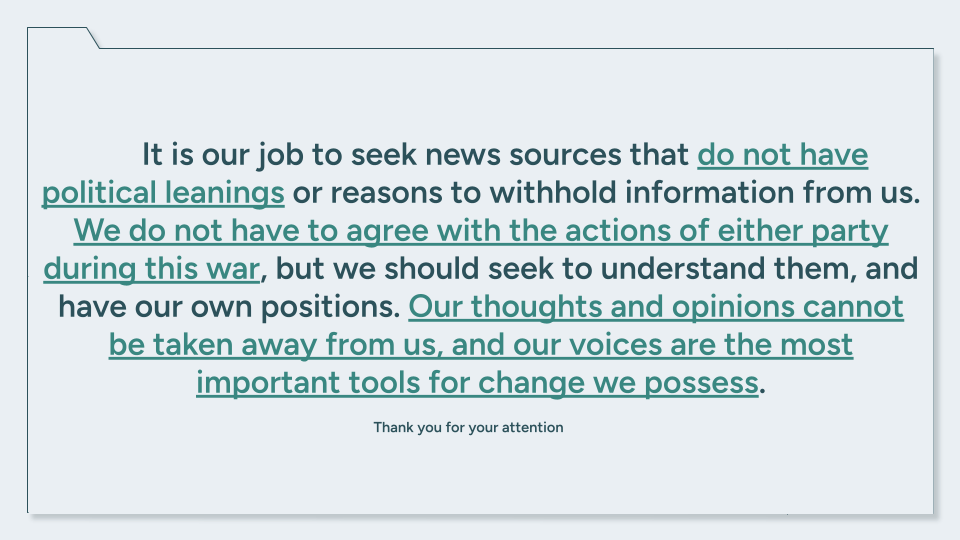
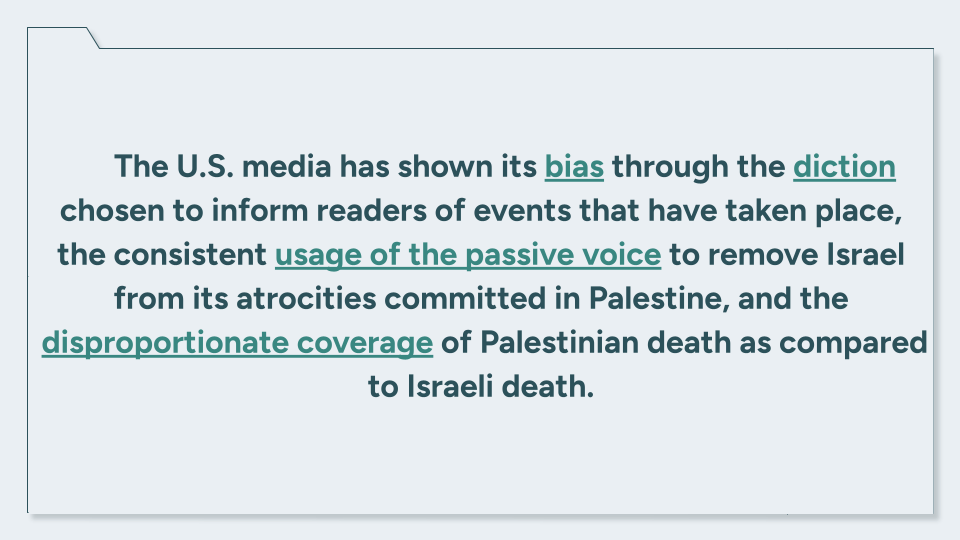
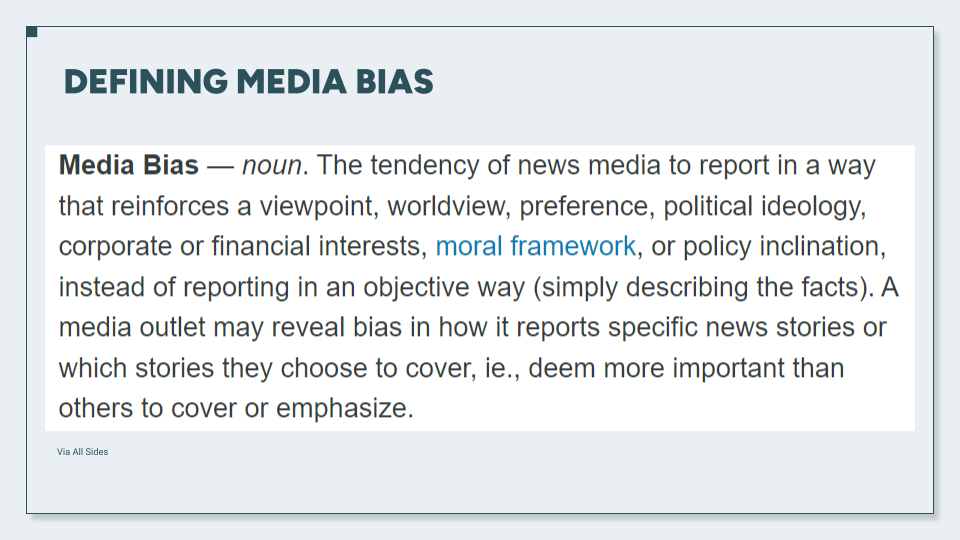
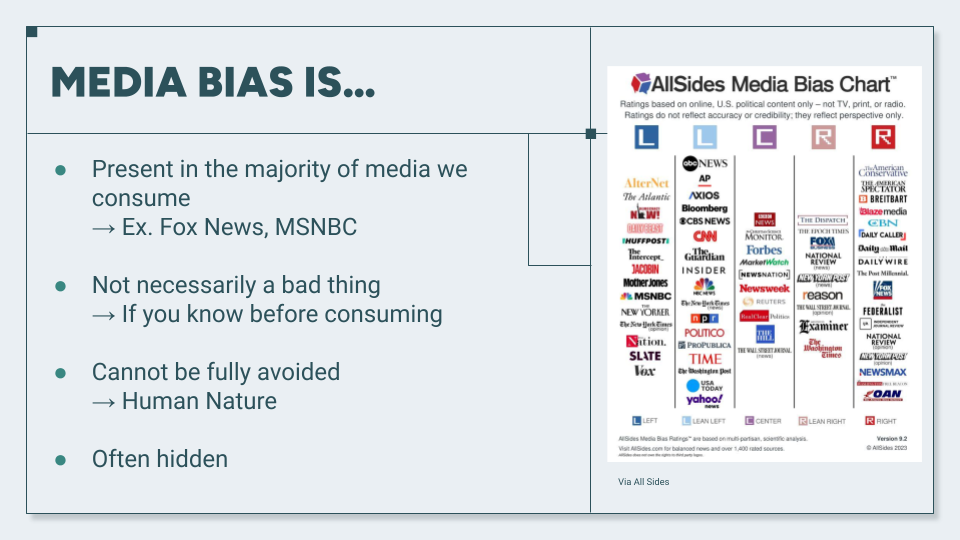

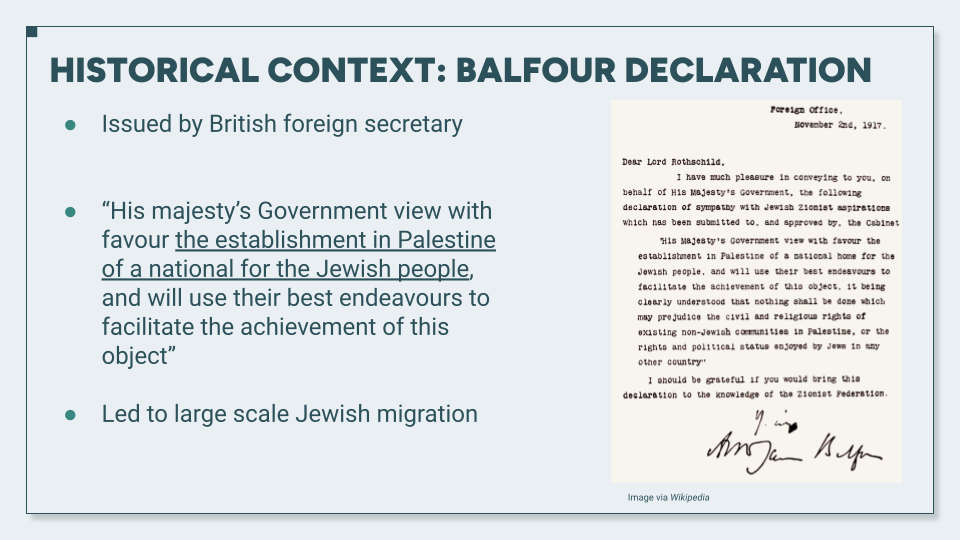
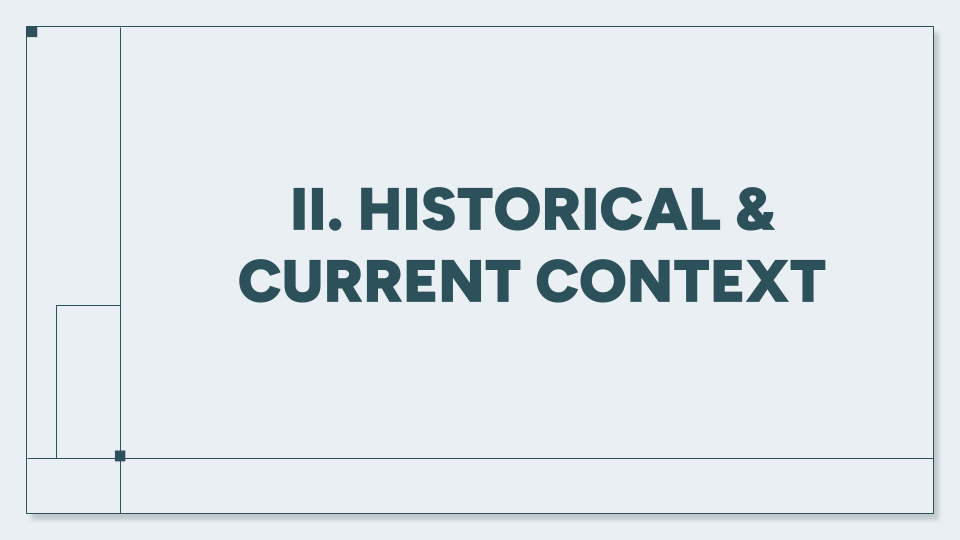
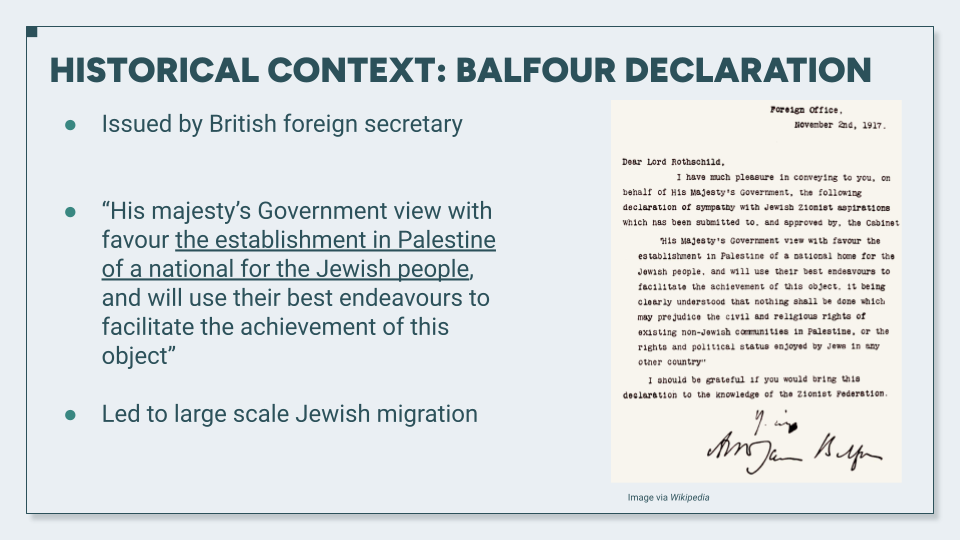
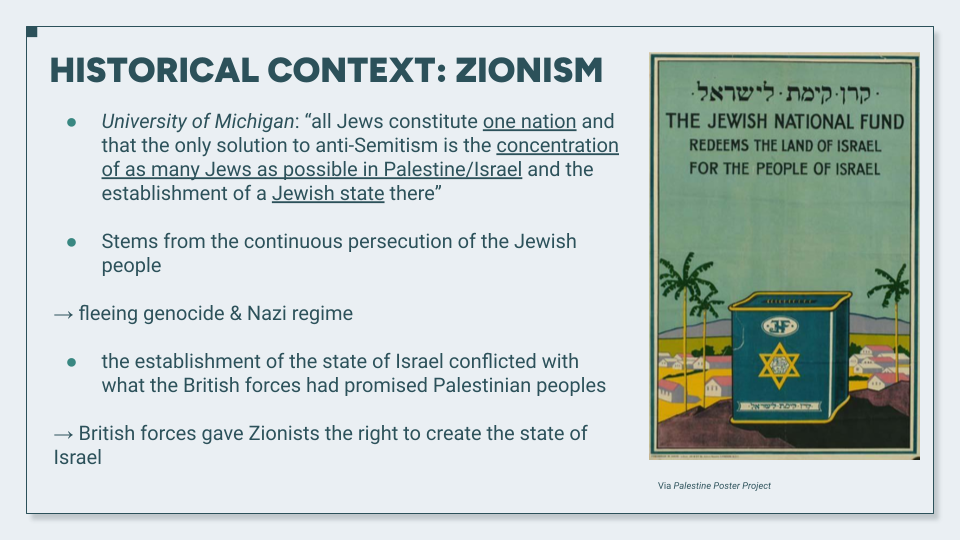
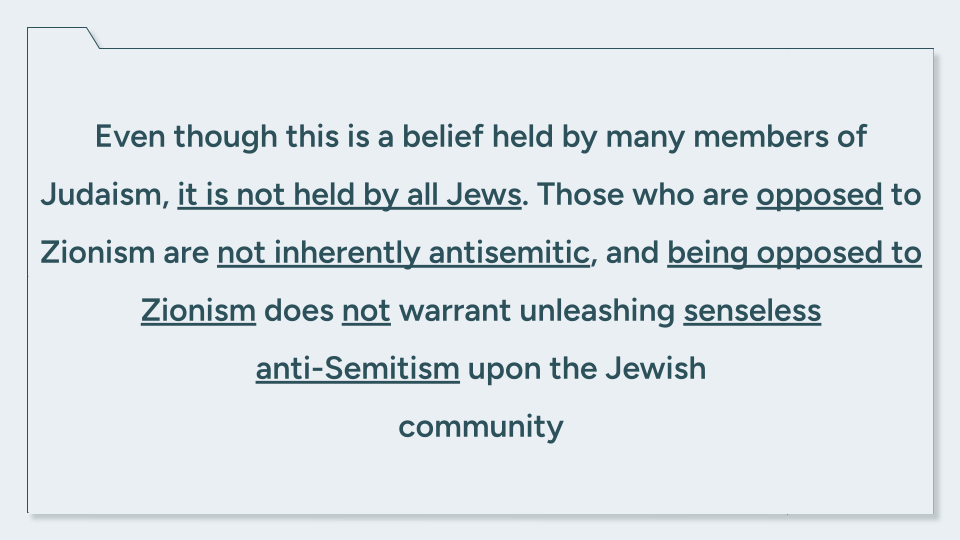
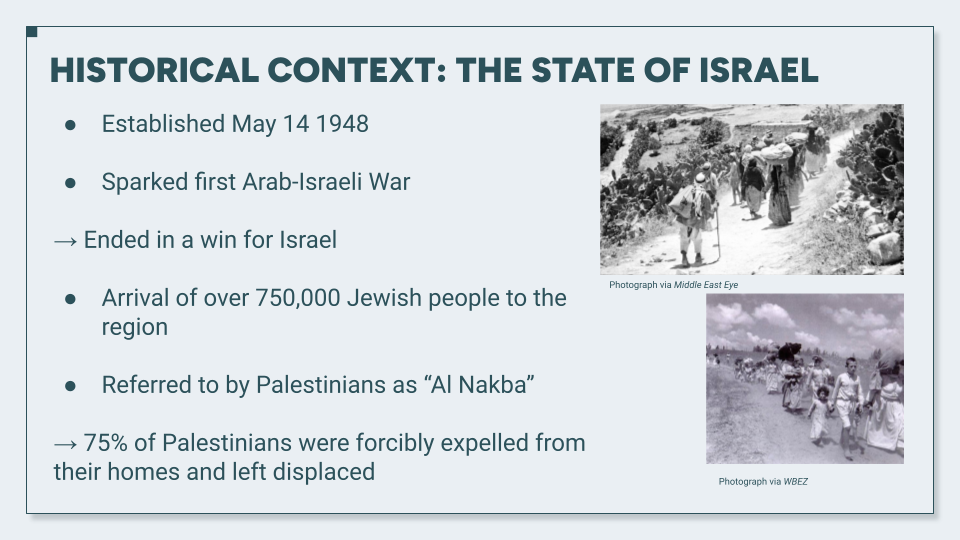



 RSS Feed
RSS Feed